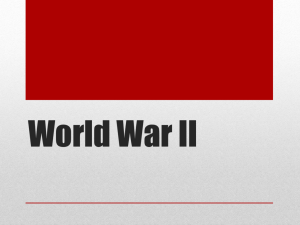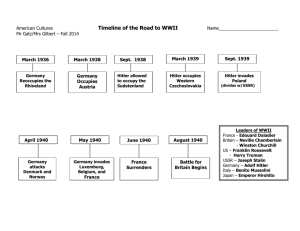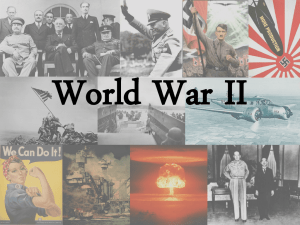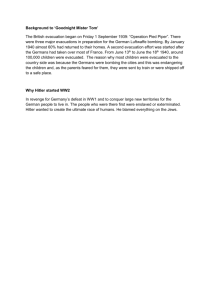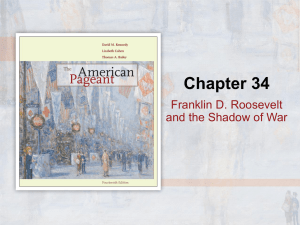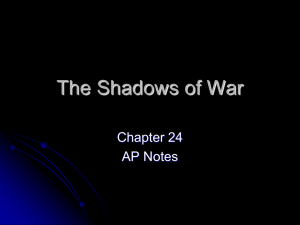WWII part 1a
advertisement
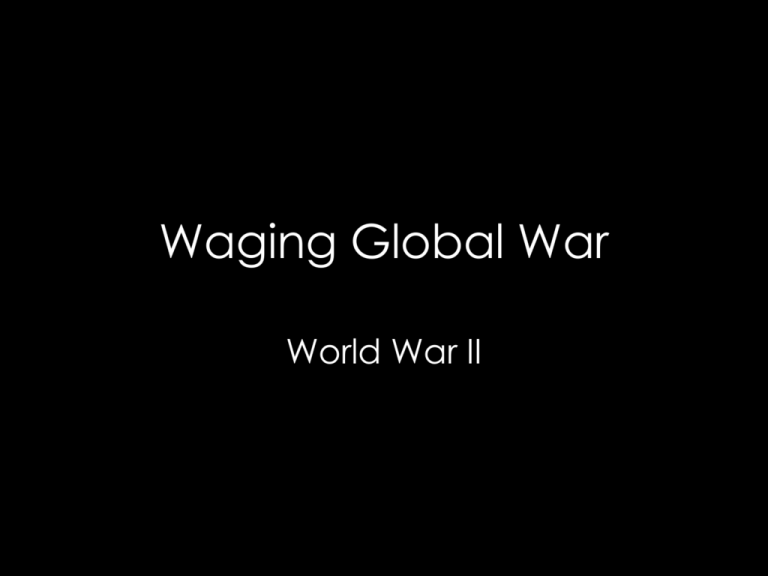
Waging Global War World War II Key Questions 1. How did the American people and government respond to the international crises of the 1930’s? 2. What are the major phases of WWII? I. Timeline: major phases of World War II The Expansion of Nazi Germany and Fascist Italy in Europe 1939-1942 Liberation of Europe by the Allies 1942-1945 American Mood: No More War • Concerned with rising fascism but determined not to be pulled into another war • Viewed involvement in WWI as a mistake • Congress passes the Neutrality Acts 1935-1937 Neutrality Acts 1935, 1936, 1937 • If there’s a war, restrictions automatically take effect • Americans could not: – sail on belligerent country’s ships, – sell weapons – lend money (regardless if aggressor or victim nations) Hesitant Responses to the Fascist Challenge Stage 1: Axis Victories A. Axis offensives in Europe 1938-1939 The Gathering Storm • 1939 Hitler seizes the remainder of Czechoslovakia • Threatens to attack Poland • Signs Nazi-Soviet non-aggression pact – ensures Russian neutrality during German invasion of Poland in exchange for territory in Finland & Baltic states • Americans grow alarmed, some push for more active American role – FDR agrees but not Congress War Begins – Hitler’s Belligerency and US’s Neutrality • September 1, 1939 - Hitler invades Poland – WWII begins • Britain and France in need of weapons • US passes Neutrality Act 1939 – European democracies can buy weapons on a Cash & Carry basis – US is no longer truly neutral Axis Victories continued • France and Great Britain declare war on Germany but no combat until spring • After victory Poland, Nazi Germany attacks Northern and Western Europe (April 1940) • Blitzkrieg (lightning war) enables quick victories over Norway, Denmark, Netherlands, Belgium The Fall of France • June 1940, France falls to Hitler • Armistice signed June 22nd • Demarcation line between Occupied France (north) and “Free” France (south under Vichy) • England stands alone in Europe • US begins building its military • September 6, 1940 – 1st Peace-time conscription law passed in the U.S. Marshal Petain, head of the French state established at the spa town of Vichy, shaking hands with Hitler. Charles de Gaulle accompanies King George VI in an inspection of Free French troops, summer 1940. The English Campaign • August 1940 Germany bombs England in preparation for an invasion (The Blitz) • Hitler’s systemic bombing fails to overcome British resistance led by Winston Churchill • Hitler renounces a land invasion Bolstering Britain with the Destroyer Deal (1940) • “Fortress of America” or Help to Britain? • Committee to Defend America – Favors aiding allies (Weapons, money, etc.) • America First Committee – Against American involvement • September 1940, Roosevelt gives UK ships from WWI in return for bases • Most Americans favored any aid necessary, short of war • Video: London Blitz & US Isolationism Congress passes the Lend Lease Act • What was it? – – – – March, 1941 Send supplies to victims of aggression “Billions not bodies” FDR: like lending a neighbor a garden hose Video: Lend lease, The Roosevelts • Seen as an economic declaration of war • Officially marked the end of neutrality – Germany begins sinking US ships B. The War goes Global • Conflict extends to the Mediterranean • Axis powers attempt to cut off UK access to Suez Canal and oil supplies in Middle East to isolate India • Axis push UK out of Egypt • Germans take Yugoslavia & Greece in April 1941 Hitler’s Assault on the Soviet Union • June 22, 1941 - Operation Barbarossa The Russian counterattack of December used troops trained and equipped to operate in the sub-zero conditions. German commanders were badly shaken, and Hitler assumed personal command of the army, ordering his men to hold on regardless of cost. Other Russian Tactics included: •Destroying all resources (burning crops, etc) while retreating •Dismantling and transporting factories East as retreated •Trained Partisan groups prepared to enter fighting Atlantic Charter – Roosevelt and Churchill meet • Stalin not invited – Outline goals for postwar world – No territorial changes – New League of Nations Video: Atlantic Charter The Roosevelts US Destroyers and Hitler’s U-Boat Clash • July 1941, FDR decides US ships will escort Lend-Lease supplies to Iceland – Roosevelt orders a “shoot on sight” policy • November 1941 – Merchant ships can be legally armed HOMEWORK Reading Material Mastering Modern World History Part I. War and International Relations Chapter 6 The Second World War, 1939-1945 (pp. 89- 95)

